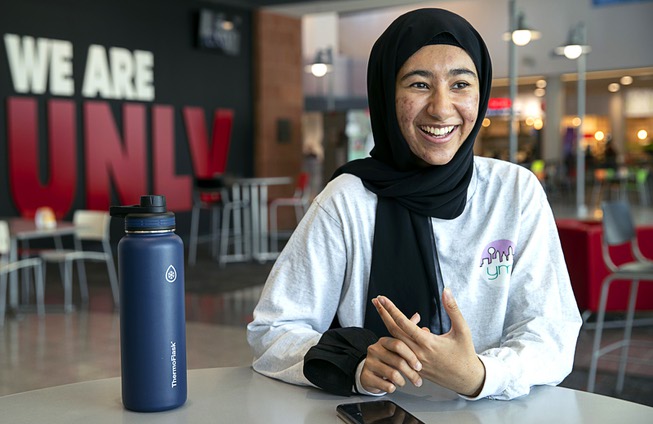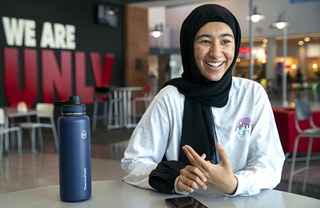
Maryam Raja, president of UNLVs South Asian Student Association, talks about President Biden’s student loan forgiveness plan during an interview at UNLV Thursday, Aug. 25, 2022.
Tuesday, Aug. 30, 2022 | 2 a.m.
Vacations were few and far between for Nicole Platt and her two brothers during their childhood.
The family opted to invest put their money toward something they felt was more pressing, although one year they all went to Disneyland.
It wasn’t that the Platts had trouble making ends meet, she said, but rather, they scrimped and saved whenever they could so the children could attend college without the burden of expensive student loans.
The plan worked.
The 24-year-old is pursuing a master’s degree in couples and family therapy at UNLV, and even in graduate school, she will be able to finish her degree without taking any student loans. Her two brothers have also gone off to college as well.
“I’m very fortunate because my family purposely saved money for me not to take out loans,” Platt said. “We didn’t take vacations at all growing up, and it was purposely for us to have enough money to go to college and not having to get loans and be in debt.”
So when news broke last week of the Biden administration’s plans to eliminate up to $20,000 in federal student debt for millions of borrowers, Platt shrugged it off. Her school has already been paid for, and several of her friends will have at least some of their debt wiped, she said.
Platt’s parents, however, told her the news was more akin to a slap in the face, she said.
“They were the ones for decades who put money aside for us" Platt said. “Maybe we could have taken out some loans and then had a few nice vacations.”
Last week’s announcement from the White House was met with criticism and praise from both sides of the political spectrum, with several Democrats claiming the move was not sweeping enough, and Republicans slamming the decision as an uber-target bailout.
Maryam Raja, a junior studying political science and president ofUNLVs South Asian Student Association, acknowledged that there would be criticism of the program, including that many borrowers would still have student loan debt. But overall, the plan would be helpful.
“I think there will be a lot of students who will see a positive difference in their education and in their financial needs to pursue higher education,” Raja said. “I think it’s really important that we don’t necessarily say this program sucks, or whatever, because at the end of there day there will still be a lot of students that will be helped, especially if they are aspiring for goals like going to graduate school.”
The Biden’s administration final framework for the plan isn’t complete, but borrowers will be eligible for $10,000 in debt relief on the sole cognition they earn less than $125,000 a year or are in households earning less than $250.000. Students who received Pell Grants — which primarily target minority or low-income students — will be eligible for $20,000 in forgiveness.
That’s also in addition to reforms to the U.S. Department of Education’s income-driven repayment program, as well as changes to interest rates for borrowers making on-time payments.
The Department of Education said about 60% of borrowers have received Pell Grants, and that 27 million borrowers will be eligible for the $20,000 in relief, while upwards of 43 million will be eligible for the $10,000. Up to 20 million will have their loans fully canceled, according to the White House.
In Nevada, thousands will be eligible for at least partial student loan forgiveness, according to figures kept by the Nevada System of Higher Education. From the 2018-19 academic year to 2020-21, the NHSE has dispersed 75,543 loans, totaling more than $812 million.
Still, there are many borrowers who moved to Nevada after college, or have loans that date back further than 2018, said Renee Davis, interim vice chancellor for academic and student affairs for the NSHE. And while the decision to cancel about $300 billion in debt will have a massive impact, Davis argues the core issue is that decades of tuition increases have made secondary education a struggle.
“By and large, this is a policy that is going to impact individuals who are no longer students,” Davis said. “My first reaction is that this isn’t really doing anything to help current students, and it’s not addressing the root issues at all.”
For Abigail Enright, the Biden administration’s decision will be a lifeline for students who choose to pursue a degree by going to community college first. She’s the director of financial aid at the College of Southern Nevada, and she argues the move will help students continue their education, or come back to finish a degree.
At CSN, 14,777 students received some form of financial aid for the 2020-’21 academic year, Enright said. Approximately 3,615 students took out at least one federal loan, and the average loan amount was $3,440.
“As a practitioner in financial aid and seeing the amount of loans students take out nowadays, I think it’s going to offer some relief for a lot of our students and graduates — relief that I guess never really has been there before,” Enright said. “Even though a lot of our student population is not taking out loans, it’s great for the ones who do.”
Still, Enright hoped something could be done about reducing the overall cost of school, whether it be tuition, books, or for some, room-and-board rates. Part of that solution, Enright said, might be expanding who is eligible for the Pell Grant.
Lourdes Gonzalez, the director of financial aid and scholarships at UNR, said about 50% of students who graduated from the institution will take out a loan at some point, and the average loan is about $23,000.
Of that, about 95% of that group will qualify for the $10,000 in debt forgiveness, and between 40% and 50% will have their debt outright canceled, she said.
“We are certainly celebrating the news because it will provide relief to thousands of our low- and middle-income students and alumni, Gonzalez said. “And this is great because it’s a step toward getting back to college affordability, but we know more needs to be done.”
At UNLV, the state’s largest public university with an enrollment of about 30,000, about 10,200 took out a loan for the 2020-’21 academic year, according to the NSHE. That’s a 9.3% decrease from 2019-20, when 11,269 students received a loan.
Davis, Enright and Gonzalez all said academic institutions are still awaiting further guidance from the Department of Education, but urge anyone seeking further information about loan forgiveness to check with their federal loan servicer. It could be several weeks before the final guidelines are out.
“The federal government is saying there might be a shot application for students to complete, and we’re trying to get everything because we want students to take advantage,” Gonzalez said. “We will be very proactive as we know more, but there are still a lot of questions.”

